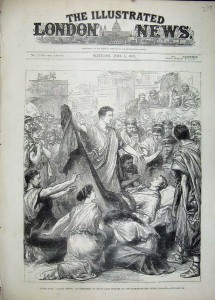“I know nothing about music, but I have been told that in certain operas Wagner divided the chorus into a number of parts, and that each group of singers represented a distinct element of the crowd, which fused into a perfect whole. Why cannot we do that on the speaking stage?” – Antoine, on inspiration from George II, in a letter to Sarcey (Carlson, 247)
In the Duke’s plays, here were no stars. He emphasized he importance of ensemble performance, and required every member in his company to be cast in leading roles on a rotating basis, allowing for the humbling and experience of every performer, and a strong ensemble.
One of George II’s greatest contributions to modern theatre is his technique for staging mass crowd scenes. When a scene required many people to be on the stage in a crowd, the Duke would choreograph the ensemble specifically. He would divide the performers into small units, each with a leader – a “dance captain” of sorts – and assign the groups individual actions, dialogue and direction. In this way, George II’s productions provided the illusion of depth and mass, without unrealistic of hyper-organization or complete and chaotic randomization. He utilized these masses to help to convey emotion and tone, and manipulated the play space to maximize these effects:
“When the impression of a great crowd is desired, one should place the groups so that the people on the sides are lost in the shadows of the wings. No one in the audience can be permitted to see where the grouping stops. The grouping must give the illusion that other crowds are also forming behind the scene” (George II, 78).

